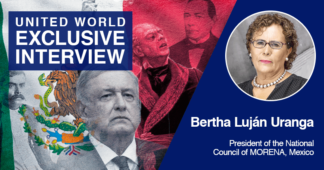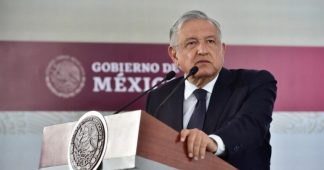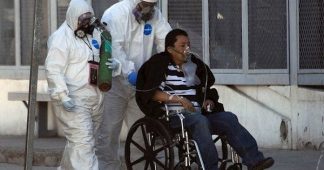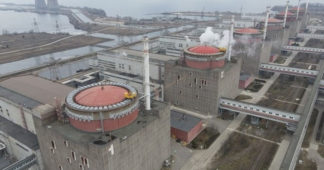Growing strength of independent Mexican labor movement today draws on legacy of striking Ford workers.
By Rob McKenzie
n the pre-dawn darkness outside Mexico City, in the dim light created by streetlamps, a group of about 300 thugs and tough guys prepare to enter the Ford Cuautitlán Assembly Plant. They are men willing to commit acts of violence for the right price and are armed with clubs and firearms.
Many have been drinking or have strengthened their resolve with drugs. They are wearing ill-fitting Ford uniforms with company ID badges displayed on their chests. The government union officials and gangsters who have hurriedly pulled the group together wait for the final OK to enter the plant.
It is January 8, 1990. The events of the next few hours will shape the lives of workers at the plant irreversibly. Within a few days, one worker will be dead. The attack will lead to a plant occupation and prolonged strike over wages, firings and democratic reforms to CTM, the government-aligned union federation. Within a few months, hundreds will have lost their jobs and the hope for a workers’ challenge to the low-wage export economy of Mexico would be dimmed.

During the 1970s, Mexico experienced good economic growth and wage gains because of its oil reserves and the likelihood of more oil being discovered.
The country borrowed heavily to finance infrastructure improvements and government spending on social programs. Due to an economic crash and falling oil prices in the early 1980s, the Mexican economy fell into significant decline.
In response the government, which the Institutional Revolutionary Party (PRI) had controlled since the 1920s, began adopting neo-liberal economic policies, which were unpopular with the Mexican people. In 1984 the CIA published an analysis for the intelligence community saying, “The Mexican political system is under greater stress today than at any time in the last 30 years.” And it was only going to get worse for the PRI.
At 7:19 a.m. on September 19, 1985, Mexico suffered an earthquake which measured a magnitude of 8.1 on the Richter scale and was followed two days later by a major aftershock. It resulted in between 5,000 and 20,000 deaths, and the collapse of more than 400 buildings, as well as major damage to another 3,000. The devastation to so many buildings laid bare the failure of the government to enforce building codes. Corruption was suspected as the primary cause.
The PRI government was paralyzed. Citizens were left to cope with rescue and relief on their own. The people of Mexico City formed organizations and began making decisions themselves. They formulated demands calling on the government to rescue all survivors, to prosecute officials responsible for structural weaknesses, and to rebuild instead of relocating people. Within days, a grassroots movement began to spread across the city.
The following April, the CIA disseminated a secret paper assessing the political impact of the quake. The document was entitled “Mexico: Political Implications of the 1985 Earthquakes—A Comparison with Nicaragua and Guatemala.” The Agency believed the PRI government’s performance was good enough that it would not affect the political stability of the country.
The assessment noted as somewhat of an afterthought that high-ranking Mexican officials had become increasingly worried due to the spontaneous organization of the new groups in the quake’s aftermath. These groups filled a vacuum created by the failure of traditional political institutions to respond to the disaster, and officials believed they posed a threat to political stability. The CIA and the U.S. Embassy dismissed these concerns as premature and an overreaction. In actuality, these groups would be the catalyst for a nationwide political upheaval that would challenge the PRI’s 60-year history of political dominance.
The July 6, 1988, election developed into the biggest challenge to the Mexican ruling elite since the 1910 revolution. Cuauhtémoc Cárdenas, who was the son of a revered former president of Mexico, Lázaro Cárdenas, defied the PRI dictatorship in 1988 and ran for President. His coalition which included communists and socialists, probably won the election but the government shut down the computer system counting the votes and had the military seize the ballot boxes.

It was a PRI election catastrophe without precedent in Mexican history. There were fraudulent practices all over the country and the opposition parties refused to accept the results. In October the Congress voted to certify PRI candidate Carlos Salinas’s victory with a margin of 260 deputies to 240 for the opposition.
This near victory of the left in Mexico catapulted the State Department and CIA into action. John D. Negroponte was appointed as Mexican ambassador within weeks of the election certification. Negroponte had been ambassador in Honduras and was tasked with the congressionally prohibited task of supporting the CIA-funded Contras. (He would later become the first Director of National Intelligence.)

Vincent Shields was simultaneously assigned to Mexico as CIA station chief. Shields was later accused of training a counter-insurgency battalion in Honduras that became a “Death Squad” during his assignment there.
In 1987, amid the turbulence of the decade, Ford Motor Company began negotiations with the CTM over a new contract at its Cuautitlán Assembly Plant (CAP) located just outside of Mexico City. Inflation was rampant, auto sales had fallen precipitously, and a layoff was needed.
Ford worked out an agreement with the CTM. The Company would not meet the government-recommended wage increase; the union would call a strike, but Ford would pay half of the worker’s wage while they were out. The Ford CTM local went on strike but under Mexican labor law an employer can terminate a contract after three months of a strike which Ford did. When the workers returned to work under the new contract, they learned that this agreement had contained what amounted to a 40% wage and benefit cut to the bargaining unit.
The workers were irate, and leadership of the local union was solidified by a reformist faction of the work force who were members or supporters of the Revolutionary Workers Party (PRT).
This was a Trotskyist group that arose from the 1968 student movement which was crushed in a massacre of hundreds of students that year. The new leadership embarked on a series of aggressive reforms that included filing grievances and holding regular meetings where workers could give voice to their problems and concerns. When they thought it appropriate, they organized unauthorized work stoppages.
The CAP local union was part of a national CTM Ford union that also included two new Ford plants recently built on the U.S. border. A new Secretary General of the Ford union, Hector Uriarte, had been appointed by the CTM leadership.
The Cuautitlán dissidents planned on running a candidate against Uriarte in the July 1988 union election and, because of the relative sizes of the locals, believed they would easily win this contest. But Ford stepped in and fired four of the top leaders of the Executive Committee, preventing them from challenging Uriarte.
We recently have learned that Uriarte was in Washington, D.C., in November 1988, meeting with the director of the AFL-CIO’s American Institute for Free Labor Development (AIFLD), William Doherty, and perhaps others in the CIA.
AIFLD had a long history of destabilizing Latin American governments the U.S. found unreliable allies in the Cold War. We now know that AIFLD was 98% government-funded, managed by CIA agents, and provided a labor cover by the AFL-CIO leadership. AIFLD had located their Mexico headquarters inside the CTM office building in Mexico City. They kept close tabs on what was going on at Ford Cuautitlán.
With the discharge of the local leadership the struggle at Ford went to a new level. The workers in the plant rejected the national Executive Committee’s attempts to direct the local, as it was clear that they had gained office through the firings of their potential opponents.
The activists formed the Ford Workers Democratic Movement (FWDM). The FWDM started a rank-and-file newsletter called En La Linea (On the Line). Two of the fired Executive Committee members began a hunger strike that was positioned in front of the Ford Motor general offices. The strike lasted 38 days and gained media attention.

The fired Executive Committee continued to act as the leadership of the local union throughout 1989. In December, a major problem developed in the plant. In the spring of that year, Ford had made profit-sharing payments to the workers but had not withhold the taxes, in an effort to benefit the election of Uriarte.
In December, Ford de Mexico finally withheld those taxes from paychecks. It resulted in tiny paychecks. As a result, some workers received nothing; most suspected Uriarte of corruption.
On December 21, 1989, the workers walked off their jobs and blocked a highway in front of the plant, demanding restoration of their salaries, reinstatement of the fired Executive Committee members and a new democratic congress of the CTM. After CTM Secretary-General Velázquez met with the workers and agreed to do so again on January 8, 1990, the workers went on the annual Christmas week shutdown.
On January 3, work resumed at the CAP. On Friday, January 5, local leaders came to the plant to hand out a leaflet calling on workers to attend the scheduled meeting with CTM Secretary-General Velázquez.

Soon, about 30 thugs attacked the six workers handing out the leaflets in the vicinity of the plant. These leaders were then taken away. When the workers in the plant learned of the disappearances, they stopped work and halted production but remained in the plant. They conducted a sit-down strike and barricaded themselves in the Ford complex. By 6:00 p.m. the kidnappers, who did not identify themselves, released the six leaders.
On Monday, January 8, production was scheduled to resume. Ford had planned on firing the ten workers who led the January 5th work stoppage, and had called police in to take them out of the plant. Along with the police 300 armed thugs wearing Ford jackets and under the command of a notorious gangster entered the plant complex. They planned to prevent another work stoppage and break the FWDM. A violent confrontation ensued, and the workers drove out the attackers. Nine Ford workers were shot; Cleto Nigmo Urbina later died from his wounds.
The workers began an occupation of the Ford facility that lasted two weeks. After the police forced them out, a prolonged strike followed, concluding with 600 workers being fired. It meant the end of the rebellion. A court convicted ten of the January 8 attackers for manslaughter and assault. They were sentenced to three years in prison but served only six months.
Ford Motor management went to the U.S. Embassy and met with officials two days after the attack and subsequent occupation of the plant. The embassy reported in a cable to the Department of State that Ford claimed the attackers were PRT members who entered the plant to intimidate their work force. This showed Ford was totally confused by what had happened on January 8.

The Ford managers told officials that they had called in police to remove “non-Ford employees” and did not understand why police had done nothing to stop the intruders. Ford has only once commented publicly—at a stockholders’ meeting—about the event. The Company CEO categorically denied paying the attackers or providing them with company uniforms asking the questioner, “Why would we pay someone to come into our plant and attack our workers?”
The Department of State adopted the position that this had been just an internal union conflict, in effect accusing the CTM of orchestrating the violence. The problem with this is that the CTM never accepted any responsibility for the event. When finally questioned four years after January 8, Uriarte denied participating in the violence at the Ford plant and claimed to have no role in the killing of Cleto Nigmo Urbina.
Blas Chumacero, the second highest official in the CTM, blamed Ford, telling the Mexican Congress, “The events were provoked by people from outside the union. Let us speak with clarity: The company is responsible and can always find people at its service for these kinds of illegal acts.”
On January 17, Silvestre González Portillo, the head of the National Union of Automobile Workers, CTM (the Ford union was an affiliate of this organization), held a press conference. He called on the Interior Minister to prosecute Wallace de la Mancha for criminal attacks on workers on several occasions, the Cuautitlán attack being the latest.
Wallace de la Mancha was a well-known gangster with a murky past who the press widely reported to be in command of the January 8 assault on the workers. De la Mancha is never mentioned in the 11 U.S. Embassy cables on the events and died under suspicious circumstances, probably assassinated, a few months later.
Classified CIA documents show the CIA was watching the PRT closely and was concerned they might be establishing a base in the working class. Victor Marchetti, who was executive assistant to the deputy director of the CIA in the late 1960s, describes Mancha’s likely fate in a documentary film broadcast in 1980:
“In the setup, the agency has where the dirty work is done by contract people or one-time hires and so forth, obviously if
anything goes wrong they can be disavowed. If the person turns bad, turns sour and may want to speak out, and may possibly have some credibility and/or evidence well then, stronger action is called for, the ultimate termination of the agent.”

On February 3, 2022, workers at the General Motors (GM) facility in Silao, Mexico, voted resoundingly to be represented by the National Independent Union for Workers in the Automotive Industry (SINTTIA), a newly formed automotive industry union recently organized by workers at the assembly plant.

SINTTIA, which was widely recognized as the only independent union on the ballot, won in a landslide victory and garnered more than 4,100 votes. The leaders of the new union credited a veteran of the struggle at Ford Cuautitlán for helping make their victory possible. SINTTIA is one of several new independent unions that have recently formed.
It took 30 years after the defeat of the FWDM before an independent union movement reorganized and challenged auto employers in Mexico, but today hope is real that the union movement will make a big impact.
We remind our readers that publication of articles on our site does not mean that we agree with what is written. Our policy is to publish anything which we consider of interest, so as to assist our readers in forming their opinions. Sometimes we even publish articles with which we totally disagree, since we believe it is important for our readers to be informed on as wide a spectrum of views as possible.











